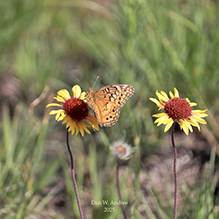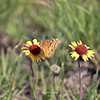great blanketflower
(Gaillardia aristata)
Conservation • Description • Habitat • Ecology • Use • Distribution • Taxonomy
|
|
||||||||||||||
Description |
Great blanketflower, more commonly known simply as blanketflower, is a native prairie wildflower. It occurs throughout the United States and southern Canada. It is native in the U.S. from Washington State to northern Oregon, east to northwestern Minnesota and Colorado. It is often cultivated. Where it occurs in other parts of the country it may have escaped cultivation and become naturalized. Great blanketflower is found in open places, including prairies, meadows, and grassy forest openings. It is also frequently found on roadsides. It grows under full sun in dry, well drained, loamy, rocky, or gravelly-sandy soil. Great blanketflower is an erect, perennial forb that rises usually on several stems from a slender taproot. The stems are unbranched, hairy, and 8″ to 32″ (20 to 80 cm) tall. There are leaves rising from the base (basal leaves) and stem leaves, but the leaves are mostly basal. Basal leaves have a 2″ to 6″ (5 to 15 cm) long, petiole-like (petiolar) base. The leaf blades are narrow, inversely lance shaped to lance shaped, 2″ to 6″ (5 to 15 cm) long, and 3⁄16″ to 1 3⁄16″ (5 to 30 mm) wide. They may be coarsely toothed, pinnately lobed (pinnatifid), or untoothed and unlobed (entire). Individual plants often have all of these – entire leaves, lobed leaves, and leaves with a few coarse teeth. The upper and lower surfaces may be rough to the touch due to minute, stiff hairs, or be sparsely to densely covered with angled (jointed) hairs. Stem leaves are alternate. They are similar to basal leaves but smaller. The inflorescence is usually a single flower head, sometimes 2 or more flower heads, each one on a leafless, 8″ to 14″ (20 to 35 mm) long or longer flower stalk (peduncle) at the end of each stem. There is a hemispherical, ⅜″ to ¾″ (9 to 30 mm) in diameter whorl (involucre) of 24 to 40 or more bracts (phyllaries) at the base of the flower head. The phyllaries are ⅜″ to ⅝″ (10 to 15 mm) long. They are egg shaped to lance shaped and are gradually tapered to a narrow tip. The margins have a fringe of hairs (ciliate). The surface is covered with straight, stiff, sharp, appressed hairs, and it is dotted with glands. The flower head has 12 to 18 or more ray florets and a disc with 60 to 120 or more disc florets. The ray florets are ⅝″ to 1⅜″ (15 to 35 mm) long or longer and are cut into three lobes at the tip. They are yellow and are usually reddish purple at the base. At least the outer half of the ray is yellow or yellow tinged with red. The disc florets are usually reddish purple, at least at the tip, but they are sometimes entirely yellow. They are tubular, with a 1⁄64″ to 1⁄16″ (0.5 to 1.5 mm) long throat, a 3⁄16″ (4.5 to 5.5 mm) long tube, and five 1⁄32″ to 1⁄16″ (1 to 2 mm) long lobes. The fruit is a dry, ⅛″ to ¼″ (2.5 to 6 mm) long seed capsule (cypsela) with a single seed. The inner cypsela are inversely pyramidal, the outer ones are club-shaped, widest at the tip. There are 8 egg-shaped to lance-shaped, bristle-like scales (pappus) attached to the broad end. |
Height |
8″ to 28″ |
Flower Color |
Yellow or yellow and purple ray florets, purplish-red disk florets |
Similar Species |
Indian blanket (Gaillardia pulchella var. pulchella) ray florets are purple from the base for at least half of their length. The achenes are much shorter. |
Habitat |
Dry. Prairie. Full sun. |
Ecology |
Flowering |
Early June to mid-August |
Pests and Diseases |
|
Use |
|
Distribution |
||
|
Sources |
|
| 7/17/2024 | ||
Nativity |
||
Native |
||
Occurrence |
||
Uncommon in Minnesota |
||
Taxonomy |
|
Kingdom |
|
Division |
Tracheophyta (Vascular Plants) |
Subdivision |
Spermatophytina (Seed Plants) |
Class |
|
Order |
Asterales (Sunflowers, Bellflowers, Fanflowers, and Allies) |
Family |
Asteraceae (Sunflowers, Daisies, Asters, and Allies) |
Subfamily |
Asteroideae |
Tribe |
Helenieae |
Subtribe |
Gaillardiinae |
Genus |
Gaillardia (blanketflowers) |
Subordinate Taxa |
|
|
|
Synonyms |
|
Galardia aristata Gaillardia bicolor Gaillardia bicolor var. aristata Gaillardia bracteosa Gaillardia hallii Gaillardia perennis Gaillardia richardsonii Gaillardia roezli Gaillardia rustica Polatherus scaber Virgilia grandiflora |
|
Common Names |
|
annual gaillardia blanket flower blanketflower common blanketflower common blanket-flower common gaillardia fire-wheel fire-wheel blanket-flower gaillardia great blanketflower great blanket-flower great-flowered gaillardia Indian blanket flower rose-ring blanket-flower rose-ring gaillardia |
|
Glossary
Bract
Modified leaf at the base of a flower stalk, flower cluster, or inflorescence.
Cypsela
A dry, one-chambered, single-seeded seed capsule, formed from a single carpel, with the seed attached to the membranous outer layer (wall) only by the seed stalk; the wall, formed from the wall of the inferior ovary and also from other tissues derived from the receptacle or hypanthium, does not split open at maturity, but relies on decay or predation to release the contents.
Involucre
A whorl of bracts beneath or surrounding a flower, flower head, or flower cluster.
Peduncle
In angiosperms, the stalk of a single flower or a flower cluster; in club mosses, the stalk of a strobilus or a group of strobili.
Petiole
On plants: The stalk of a leaf blade or a compound leaf that attaches it to the stem. On ants and wasps: The constricted first one or two segments of the rear part of the body.
Phyllary
An individual bract within the involucre of a plant in the Asteraceae family.
Pinnatifid
Deeply cut, more than half way to the midrib but not to the midrib, into lobes that are spaced out along the midrib; the lobes do not form separate leaflets.
Visitor Photos |
||
Share your photo of this plant. |
||
This button not working for you? |
||
Dan W. Andree |
||
 |
 |
|
Variegated Fritillary feeding on a Blanket flower |
This yellowish spotted beetle like insect... …was also out at Frenchman’s Bluff SNA this summer… I have no idea what it is. |
|
I became acquainted with the Jackal Flies... I seen a northern crab spider on a blanket flower it had an insect caught and feeding on it when a few small flies showed up, then more and more. They somewhat circled the crab spider and a couple tried sneaking in and at times the spider would take one of its legs and flick it at the flies. |
||
Anyway I googled small flies surround a crab spider feeding. I seen a lady had a video of a crab spider that caught a honey bee and she called the flies trying to get in on it Jackal Flies. They were doing what I seen some do. But anyway I filmed it on and off for a good 2-3 minutes since the spider had turned nice colors and the flower etc. But anyway I got some nice footage and when I seen how it is laid out etc. it reminded of a small segment of something Nat. Geo. "somewhat". The photo is a frame grab from 4K video. I just shrunk down smaller. Crab spiders are neat little spiders and can change color somewhat to their surroundings. Also they are so small and harmless to people. They may take a honey bee or some other insect people wouldn’t want a spider to catch, but they aren’t a threat to any species declining because of them. Crab spiders will also feed on other insects like stink bugs, flies, and numerous others including one I seen in the past had a yellow jacket wasp for lunch. I’m not a fan of yellow jacket wasps. |
||
 |
 |
|
Small Bee on a Blanket Flower... It was really breezy so I grasped the blanket flower to hold it a little more still and the little bee just stayed on the flower. Wind can really whip plants and grasses on an open prairie. |
||
Blanket Flowers I think... These looked like they were just beginning the blooming period. They were at Frenchman’s Bluff SNA a couple days ago. |
|
|
Blanket Flower... This was out at Frenchman’s Bluff SNA. Norman county, Mn. The wind kept the flower swaying back and forth so I grasped it gently to get a stable image. Beautiful flowers they are. I have more images with a group or bunch of them together. The Blanket flower sure adds color and beauty to the prairie areas suitable for it. The name of it “blanket” gives kind of a warm thought or feeling. Colors are kind of like fiery sunset colors. I read they are a species of special concern here in Mn. |
||
 |
||
Blanket Flowers... |
||
A Monarch on Blanket Flowers... Earlier in June I seen this Monarch at Frenchman’s Bluff SNA but since have only seen a pair mating earlier in June and one other one just flying across the prairie. While the prairie has really grown some of the main flower species are just budding out and last time I was out there maybe 5% of the wild bergamot were flowering. There is a lot of bergamot and other species but haven’t blossomed out really. |
||
That will change fast though. You can see the blanket flowers were blurred somewhat due to rather breezy too darn right windy at times on that day. The Monarch was a male because when its wings were open it had a dark blackish spot on each lower wing area. Fed for a very short time and flew off in the wind. |
||
MinnesotaSeasons.com Photos |
||
|
||
|

Slideshows |
|

Visitor Videos |
||
Share your video of this plant. |
||
This button not working for you? |
||
|
Other Videos |
||
Gaillardia aristata conservation |
About
Uploaded on Jul 28, 2011 Susan talks about the conservation benefits of Gaillardia aristata, blanketflower, a perennial wildflower native to North America. Foundation seed will be available for 2012 spring seeding. For more information log onto the PLANTS Web site (http://plants.usda.gov) or contact jim.jacobs@mt.usda.gov |

Visitor Sightings |
||
Report a sighting of this plant. |
||
This button not working for you? |
||
| Dan W. Andree 6/24/2025 |
Location: Frenchman’s Bluff SNA Variegated Fritillary feeding on a Blanket flower |
 |
Dan W. Andree |
Location: Frenchman’s Bluff SNA
|
 |
Dan W. Andree |
Location: Frenchman’s Bluff SNA These looked like they were just beginning the blooming period. They were at Frenchman’s Bluff SNA a couple days ago. |
 |
MinnesotaSeasons.com Sightings |
||

|
Created: Last Updated: © MinnesotaSeasons.com. All rights reserved. |








